This guide dives into all the nuances involved in creating that perfect, professional online journalism portfolio, and will help you if you are:
- a freelance journalist
- a staff journalist
- or a journalist at any stage of your career
The article will explain why you should trust us, why you need a great journalism portfolio, cover what makes for an excellent professional online portfolio, and how you should go about creating a portfolio, with examples.
• Why you should listen to us, and why you need a journalism portfolio
• The essential qualities of an excellent journalism portfolio (with examples)
• How you can create a journalism portfolio in minutes (using Authory)
• Why you should pick Authory — automatic content importing AND permanent backup
Why should you listen to us?
Some of the most talented and successful journalists worldwide are using Authory.
For creating this comprehensive guide on making journalism portfolios, we've taken learnings from a small subsection of these folks: journalists whose work has been featured in The New York Times, CBS Sunday Morning, WIRED, Newsweek, Rolling Stone, New York Magazine, Politico, Wall Street Journal, Quartz, The Cut, The Economist, and more.
Among these Authory users are David Pogue, a six-time Emmy winner, New York Times bestselling author, and five-time TED speaker; Tony Norman, columnist for the Pittsburgh Post-Gazette and President of the National Society of Newspaper Columnists; and Steven Levy, Editor at Large for WIRED, and author of eight books covering computer technology including multi-year exposés of Apple, Google, and Facebook.
Why do you need a journalism portfolio?
Journalism portfolios are entirely different from regular writing portfolios. An online writing portfolio is excellent, but won't serve the purpose of a journalism portfolio website.
Journalists usually work under tight deadlines while reporting real-life events, finagling out sources to find the most accurate information, and doing all of the above quickly.
To that end, an excellent journalism portfolio must display your best work, portray the breadth and depth of your performance across several spheres of focus, and generally exhibit all-around professionalism. That is all so you can get more work and build your brand.
Let’s go into more detail.
1. Showcase your work
A portfolio is meant for showcasing your work so that you get more of it — that's pretty obvious. It's the same with a journalism portfolio: show off your best work but with the added emphasis on displaying the sheer volume of articles that you have worked on as a journalist — an essential aspect because consistency is something that prospective clients and publications will look for.
Hence, your ideal journalism portfolio should exhibit the various topics you've worked on, the numerous outlets you've written for, and more. On top of this, the perfect portfolio must have search and filter functions so prospects can sift through your content and find exactly what they're looking for.
2. Build your professional brand
Creating a journalism portfolio or website is a brand-building exercise — and that's a good thing. A fair few journalists are verified on Twitter with decent followings. It may not be a journalist's top consideration — reporting with integrity is definitely the main focus — but having a wide readership is always good. It will allow you to command more credence professionally while getting your work read by many.
So, it's imperative to consider a portfolio builder that looks professional but also has features that will let you engage your audience quickly, like with a newsletter. In this way, you can create a connection with your audience and build your brand.
3. Protect your work
Top journalists worldwide have lost their work when websites have gone down, migrated, or merged.
I’ve been burned many times by publications that went under, were acquired, redesigned, switched their content management system, or just unceremoniously seemed to dump old content without warning. At times, I was rigorous about making PDFs by printing Web pages, and I keep all my drafts. But I think I’ve lost hundreds of final edits and layouts since the mid-1990s of stories — often longer feature stories rather than some of the more routine stuff I write in much greater quantities.
— Glenn Fleishmann, whose work has appeared in The New York Times, The Economist, The Atlantic, Smithsonian, Fast Company, Macworld, and more.
Needless to say, it’s an excellent idea to have all of your work backed up — and a good portfolio solution should do that for you.
What makes for an excellent journalism portfolio?
At a minimum, your journalism portfolio needs to have the following:
- Your writing samples
- Your profile
- Your contact details
- And links to connect with you on social media.
But this is just the basics; an excellent journalism portfolio must be far better. Consider who the audience is for a journalism portfolio: editors of newspapers, magazines, and other publications. And what they're looking for, besides the basics, is quality and quantity of work (to judge consistency), authenticity, and quickly finding what they need.
With that said, let’s dive deeper.
1. Quality and quantity
Typically, the outright volume and variety of output journalists produce set them apart from regular writers. Some journalists on the breaking news beat publish twice or thrice a day!
Hence, an excellent journalism portfolio must display your writing abilities as well as assurance that you can write at the required scale. Editors will want to see that you're able to deliver quality consistently — they'll likely pick the journalist who has five hundred well-written pieces as opposed to one who has just five on their portfolio (even if their writing style surpasses standards.
Besides showcasing a variety of work, exhibiting quantity is proof that this is really you and your work. If your portfolio has just five pieces, those could have been strongly edited and isn't a true reflection of your capabilities. In contrast, showing more work reduces the chances that the work was interfered with by others.
2. Always up-to-date
Journalism is so much about timeliness; hence, nothing is worse than outdated articles/content in your portfolio, which can make a journalist look like they aren't on top of things or not at the top of their game.
That said, it's tough to keep your journalism portfolio updated, especially when you're publishing content at a rapid pace while trying to exhibit the quality of your writing.
That's where a self-updating portfolio like Authory is super handy. Authory will scour the internet to find all your articles regardless of where they've been published — behind paywalls, in different formats, and more.
3. Easy to navigate
Search & Filters:
The ideal portfolio builder should have search & filters. With search/filters, you're handing power over to the viewer — now, they have the freedom to navigate through your portfolio. An editor of a prominent publication is usually starved for time, and the ability to search and filter through your writing allows them to explore your work quickly and thoroughly.
Collections:
The perfect journalism portfolio must have Collections. Collections allow you to divide and curate your content into different buckets. In all likelihood, you've written on numerous topics or for various publications. Depending on your focus, you can separate your work into relevant collections that you can share with prospective clients or publication editors. That, in turn, eases navigation — a prospect can quickly go to the tab they're most interested in.
Responsiveness:
Your portfolio needs to look amazing on any device. In this day and age, this is a given, but it's something to keep in mind. It's a good idea to test your portfolio on a phone, a tablet, a laptop, and a desktop, to make sure it looks good on all these devices.
4. Variety of samples
Following on from the previous points, showcasing a variety of writing samples is the way to go for the reasons outlined above. And functionality like search/filters and collections give the user a lot of control to find what they're after.
Let’s look at a few examples to illustrate how this works.
Simon Denyer, a Pulitzer Prize-winning journalist, and author, has opted to divide his content primarily by government.
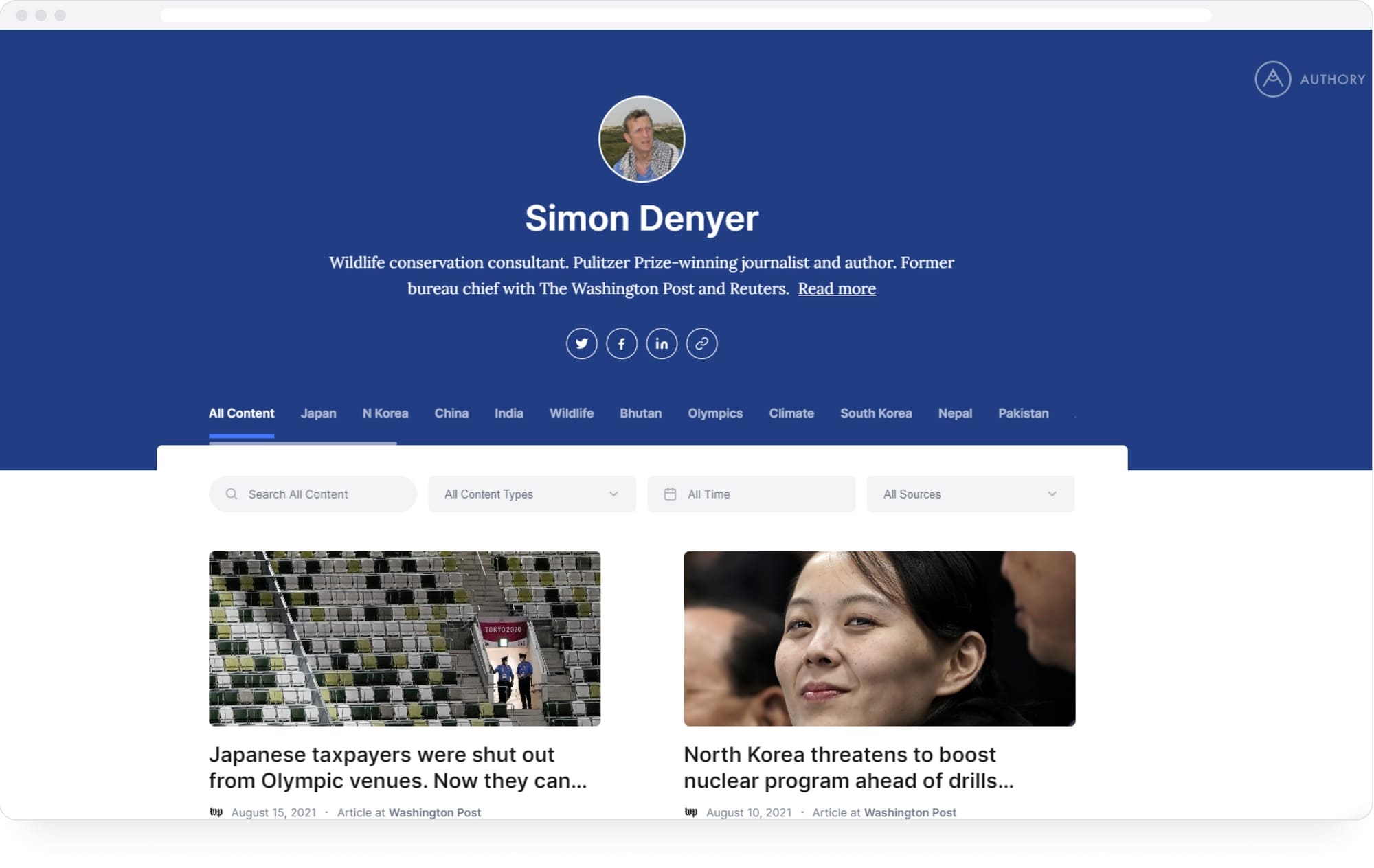
Jonathan O'Callaghan, a space and science journalist has gone in for topical curation.
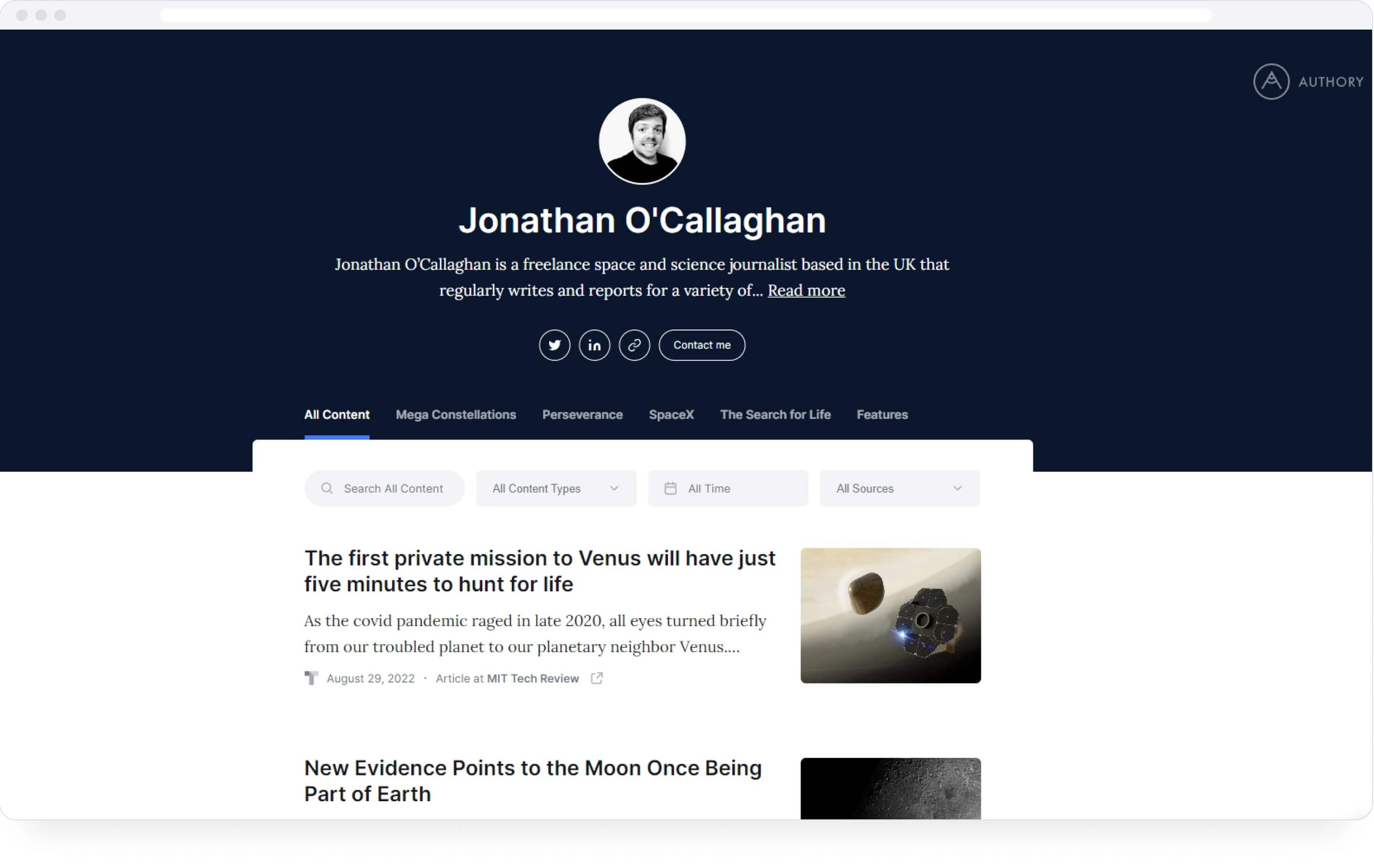
Sheena Roetman, who writes on Native American topics, has not divided her work into collections, instead choosing a minimalist layout. Authory’s search & filter functionality will stand her in good stead.

Yesha Callahan, who writes on pop culture, has, like Sheena above, favored a simplistic look. She's gone one step ahead and eschewed a background image, making her content the real centerpiece of her portfolio.
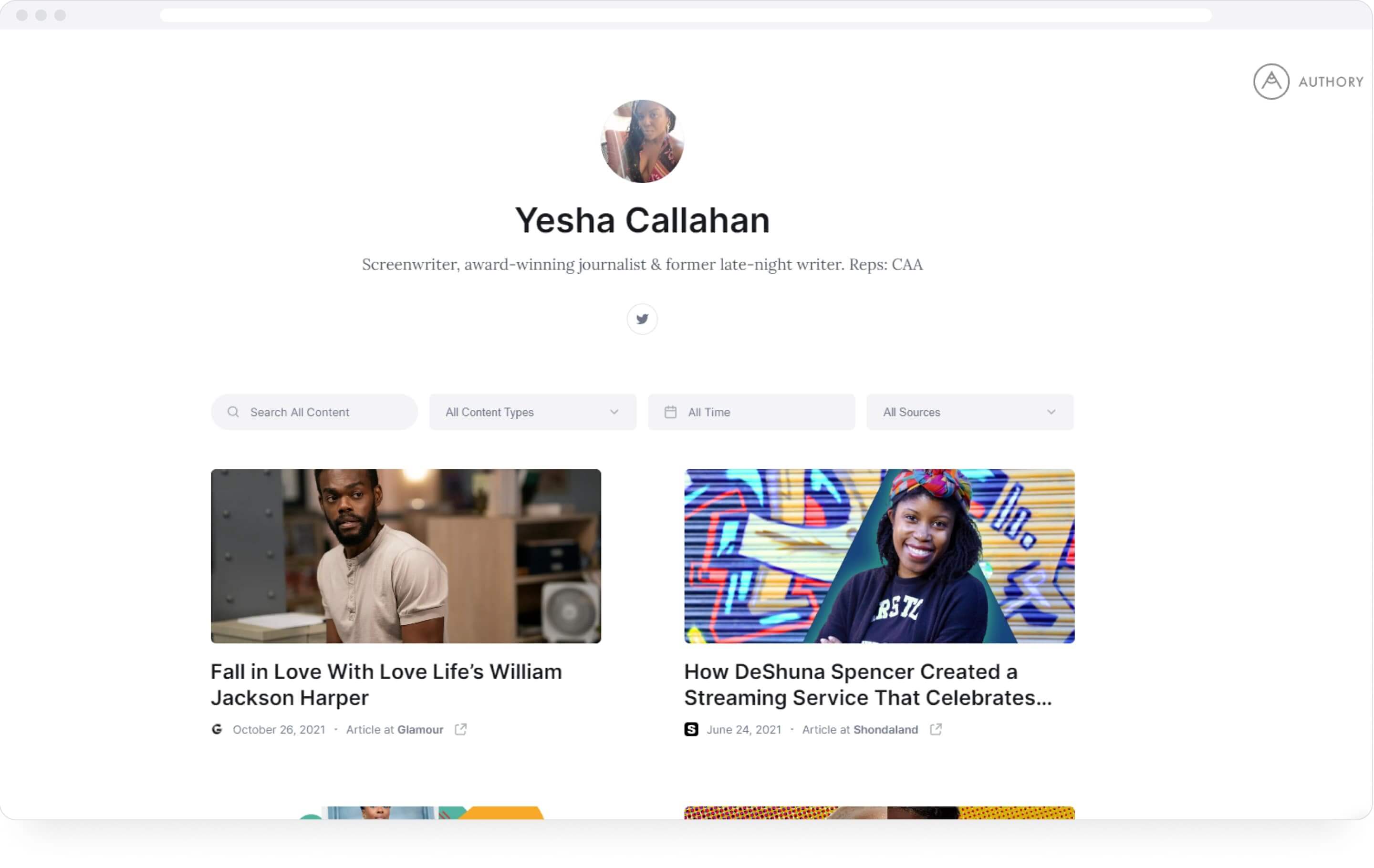
5. Different types of media
The ideal journalism portfolio builder should support not just written media (including PDFs) but audio, video, and social media content as well.
Many journalists are featured on podcasts, do video reports, and are pretty active on Twitter and other social media channels. Increasingly, these items need to be included in portfolios as they exhibit a wider skillset that potential clients and publications will be looking out for.
6. Section for when your "mentions"
As part of building your personal brand, whenever you're mentioned, quoted, or interviewed anywhere on the web, include these in your journalism portfolio as well. This can be in any format: audio, video, podcast, written word, etc. Doing so helps build your profile and authority.
Again, the use of collections can be vitally important: partition out the content created about you (or quoting you) from the content created by you.
7. Easy to set up
Generally, journalists don't have much time to work on their portfolios. Considering that you should be looking to include your entire body of work, curated for different audiences, you'll need a portfolio solution that's easy to set up and maintain.
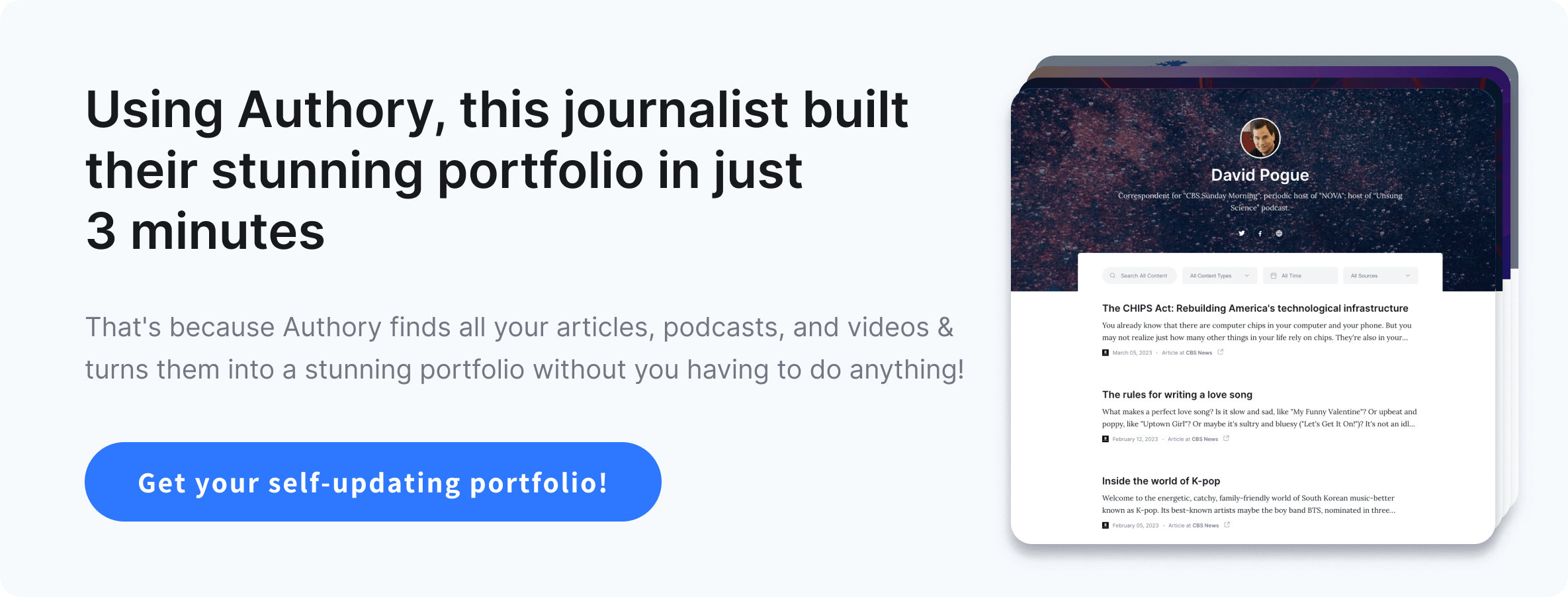
How to create the perfect journalism portfolio (using Authory)
We’ll use Authory to show you how to create the perfect portfolio in just five steps.
Step 1: Add sources
Signup for Authory with our free. After adding the places where you’ve published, Authory will automatically go there and find all your articles (and other content) and import them to your Authory account. There's no need for you to try and find any of your existing content to populate your portfolio when setting it up. Authory will do that for you.
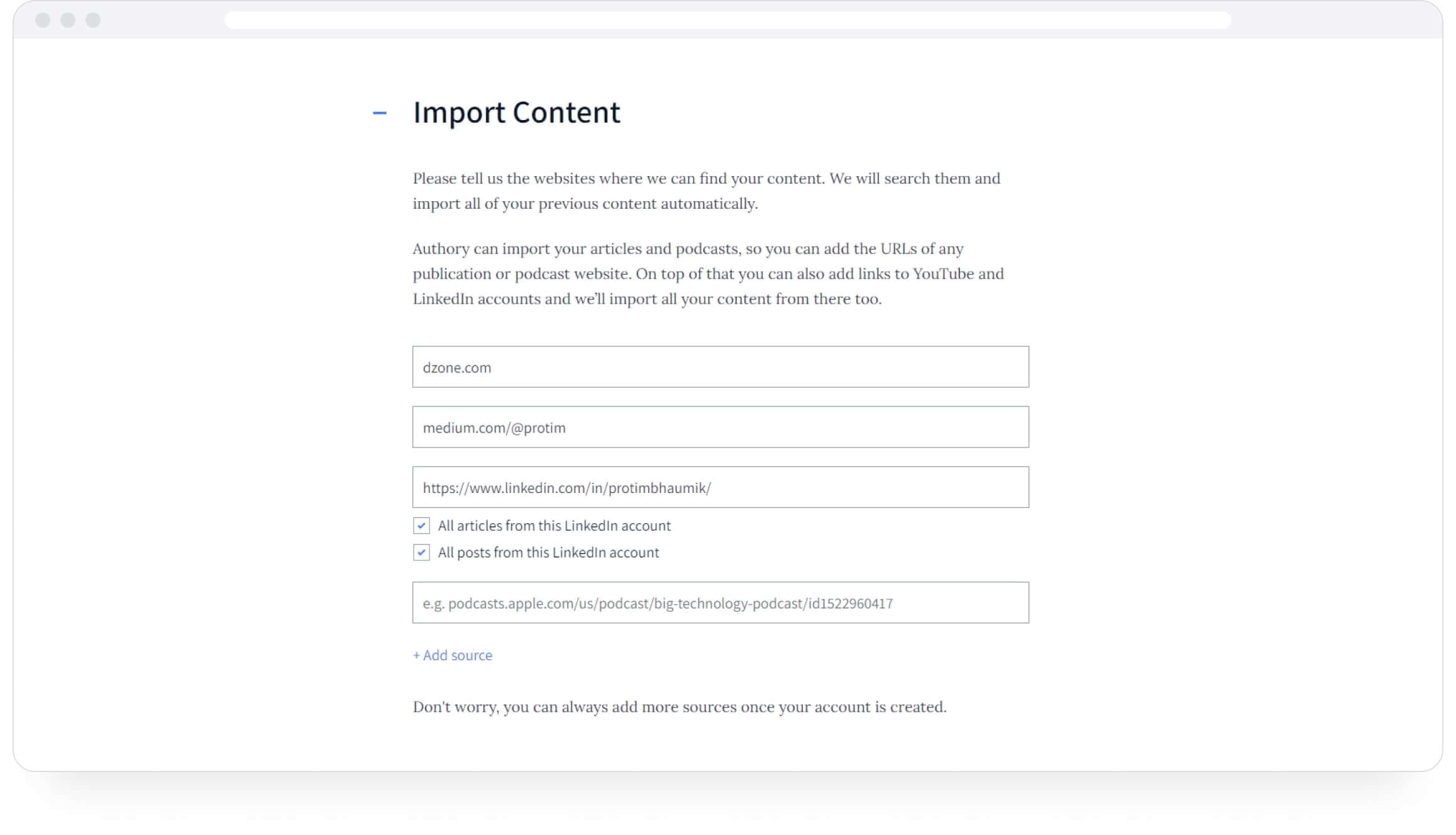
All your content will populate automatically into an "inbox" where you can see everything you've ever created all in one place.

Step 2: Create collections
Go to the collections section and click on “+ Create collection” as shown below. It's simple to create collections based on the items in your Content section.
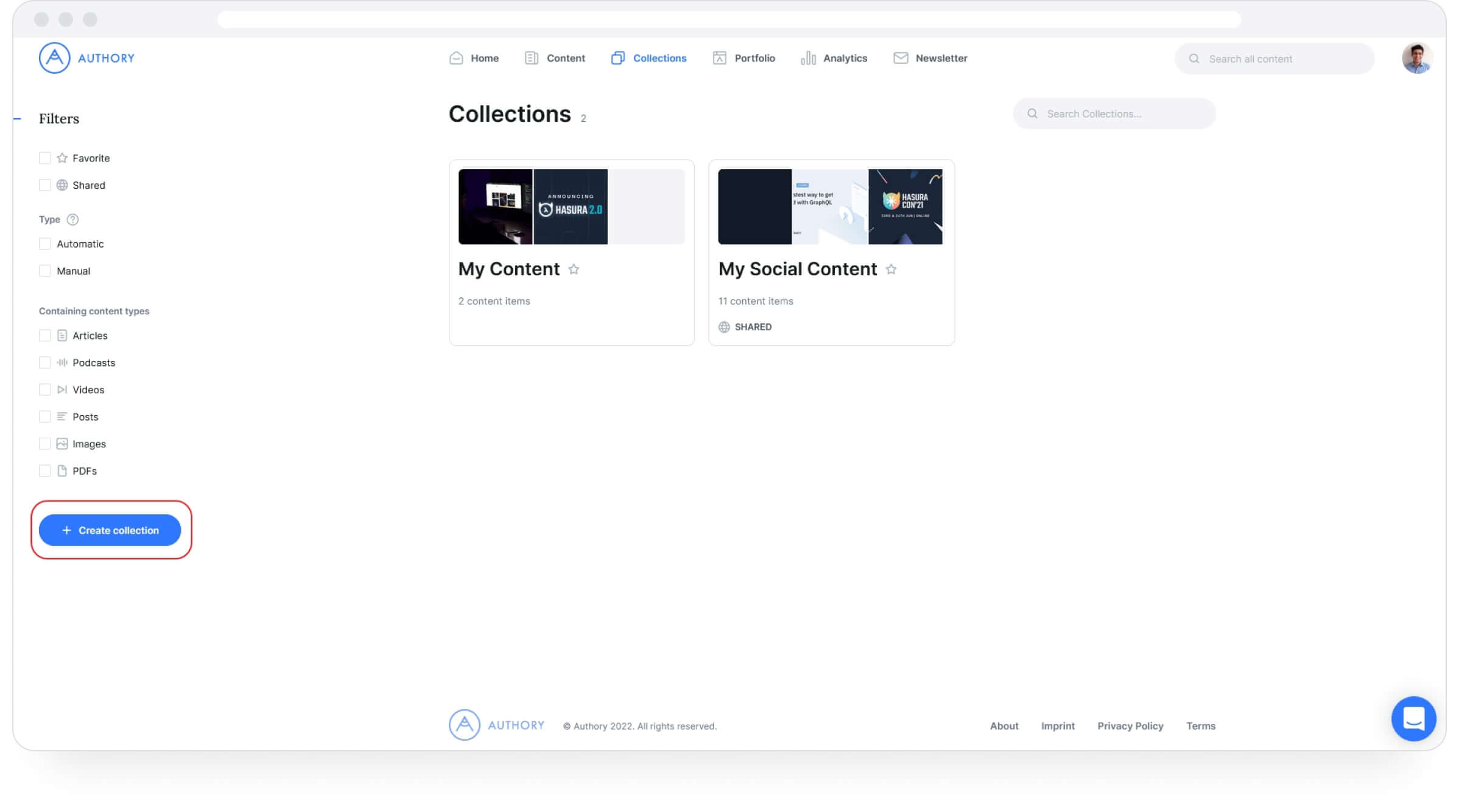
Next, name the collection and add a description.

You can add content to your collection in two ways: by adding content manually or using rules, as shown below. Click on "Set Rules.”
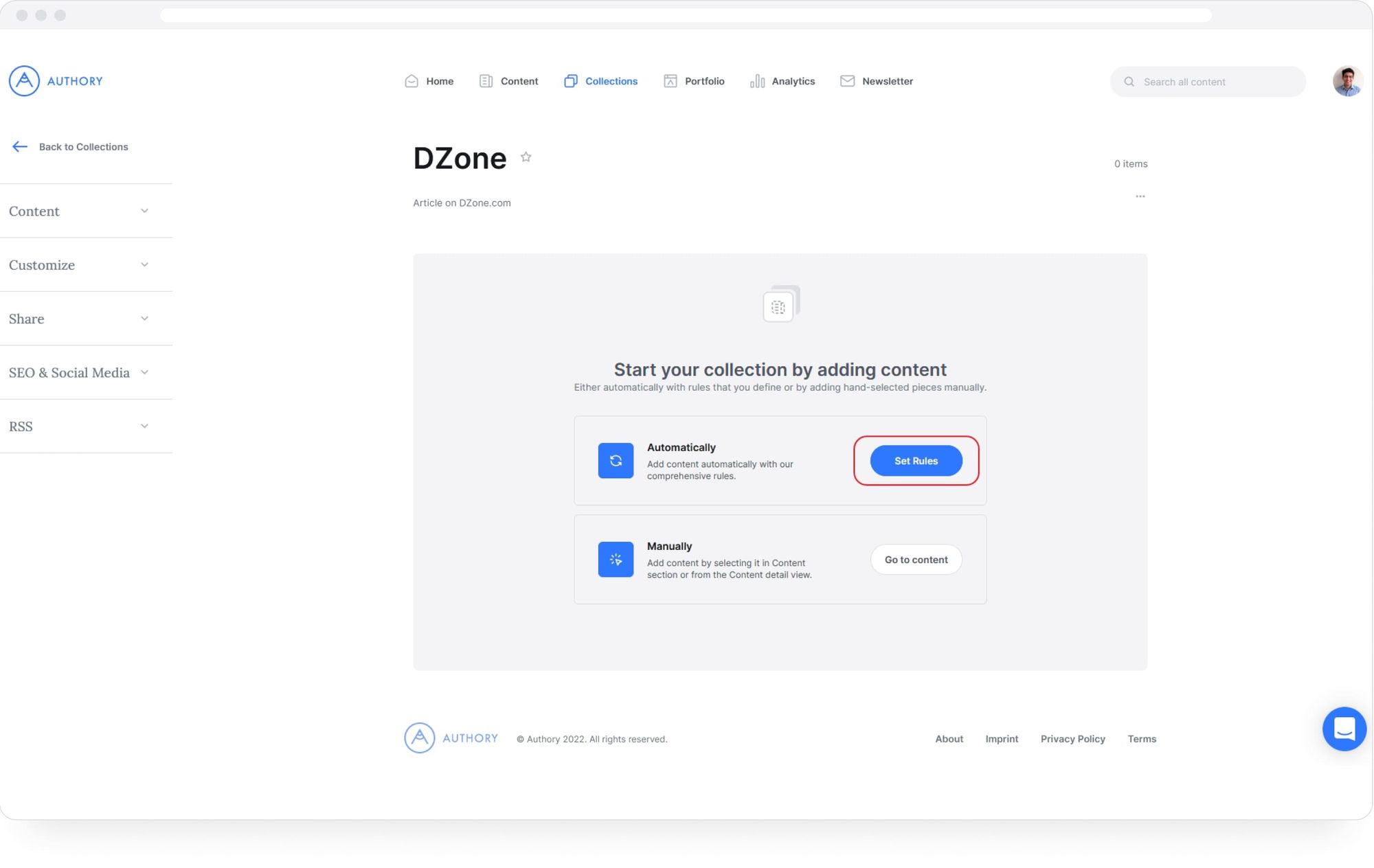
You can add keywords, sources, and content types in the Rules window. The last row allows you to clarify whether the content items need to match all the rules or whether should match any rule.

In the example below, the “Sources” option has been chosen, and Dzone.com has been selected as the source — that's all that's required to automatically create a collection containing all the content from the source Dzone.com.

This is how it looks once the collection is created.
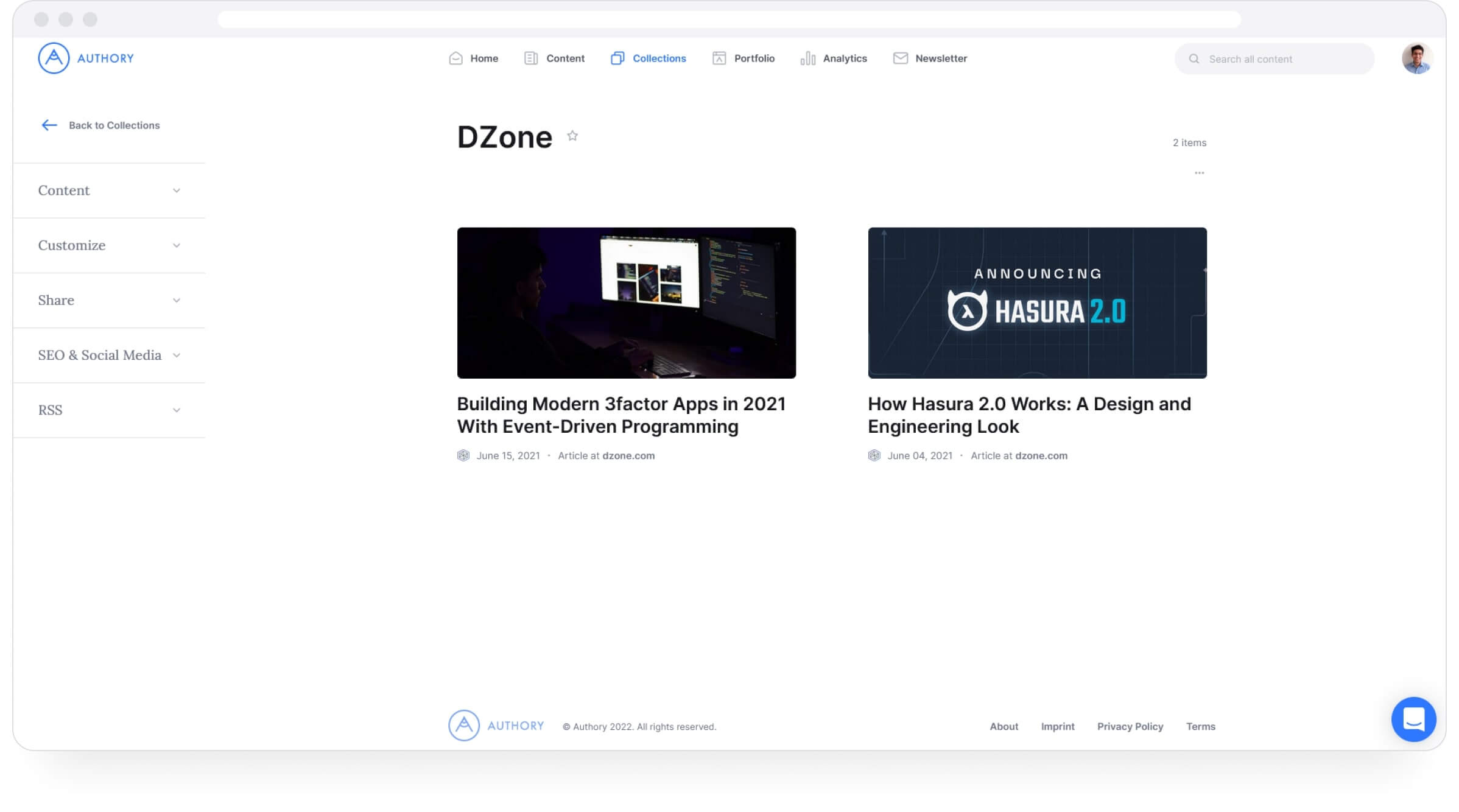
Step 3: Display your collection & design your portfolio
Now that you've created a collection, you need to add it to your portfolio so that it becomes visible on your portfolio page.
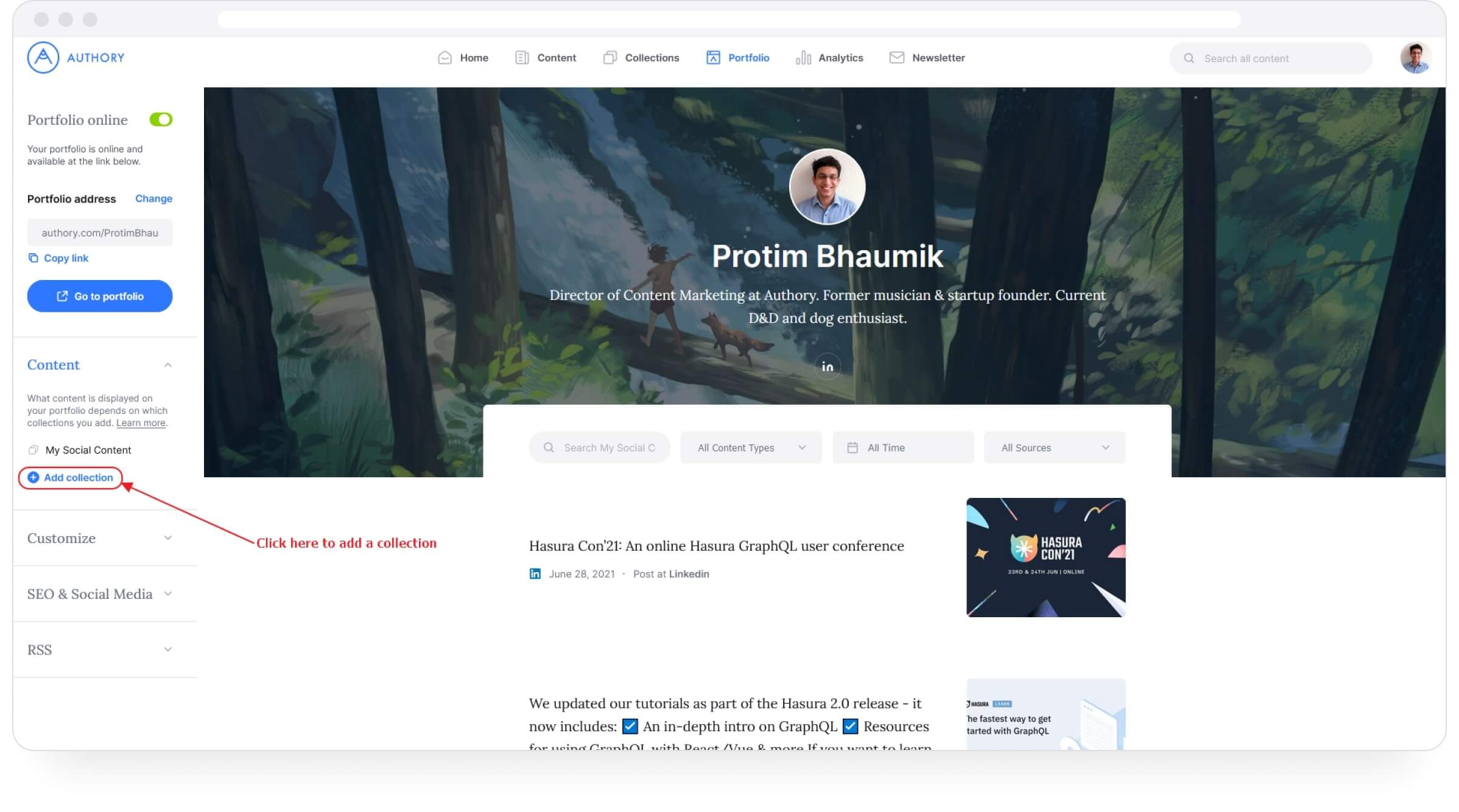
You can add more collections and they will be shown under tabbed headings. The example below has two: "DZone" and "My Social Content.”
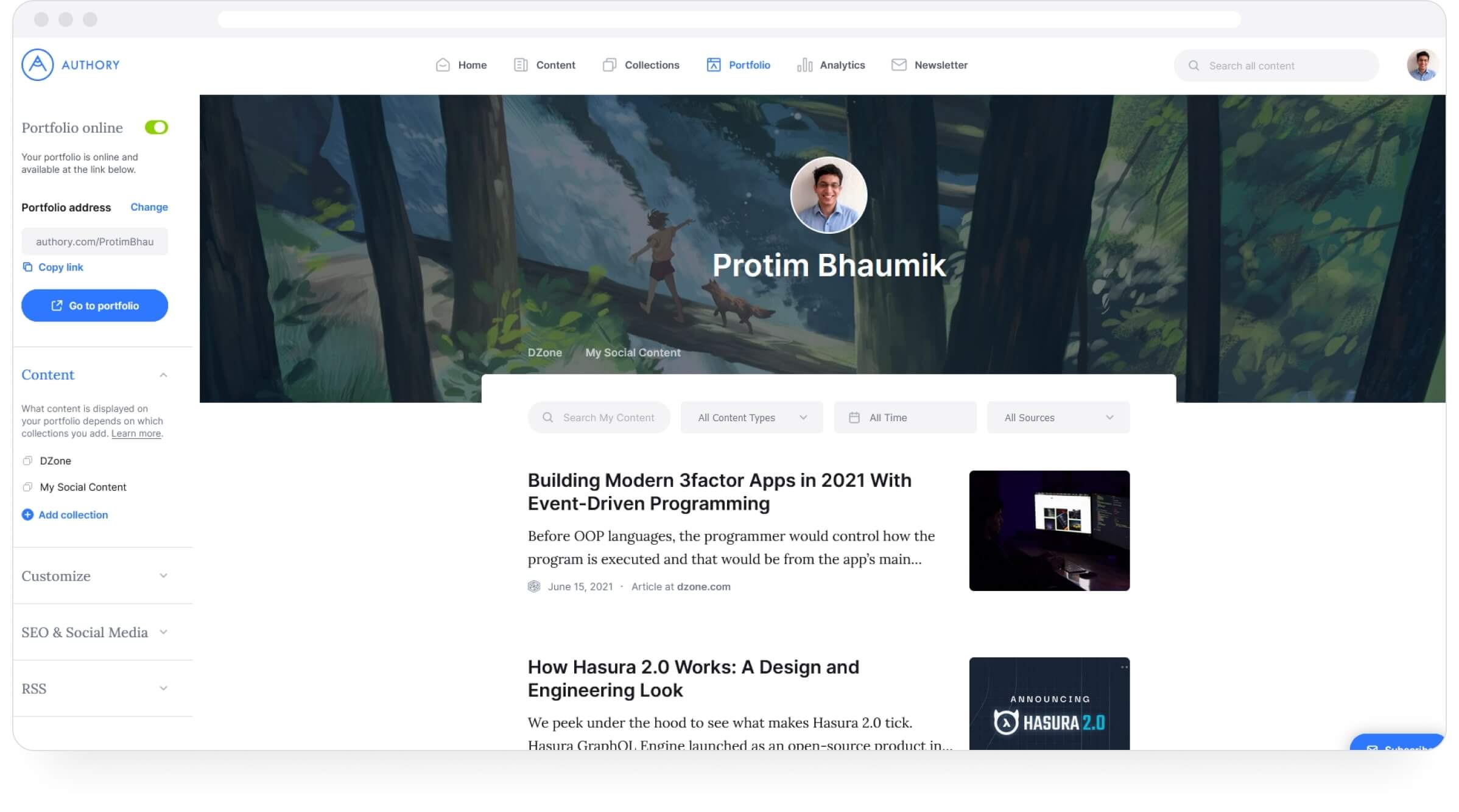
Use the "Customize" tab on the left to beautify your portfolio. You can upload a background photo or choose one from Unsplash, center or left align your header, add social media and website buttons, and more.

Step 4: Write about yourself
Now that your portfolio looks great, it’s time to edit your name and bio from the left navigation bar. The example has a small biography, but you can opt for a much longer "About me," of which Authory will display the first 140 characters in the header, and the rest will be tucked under "Read more.”
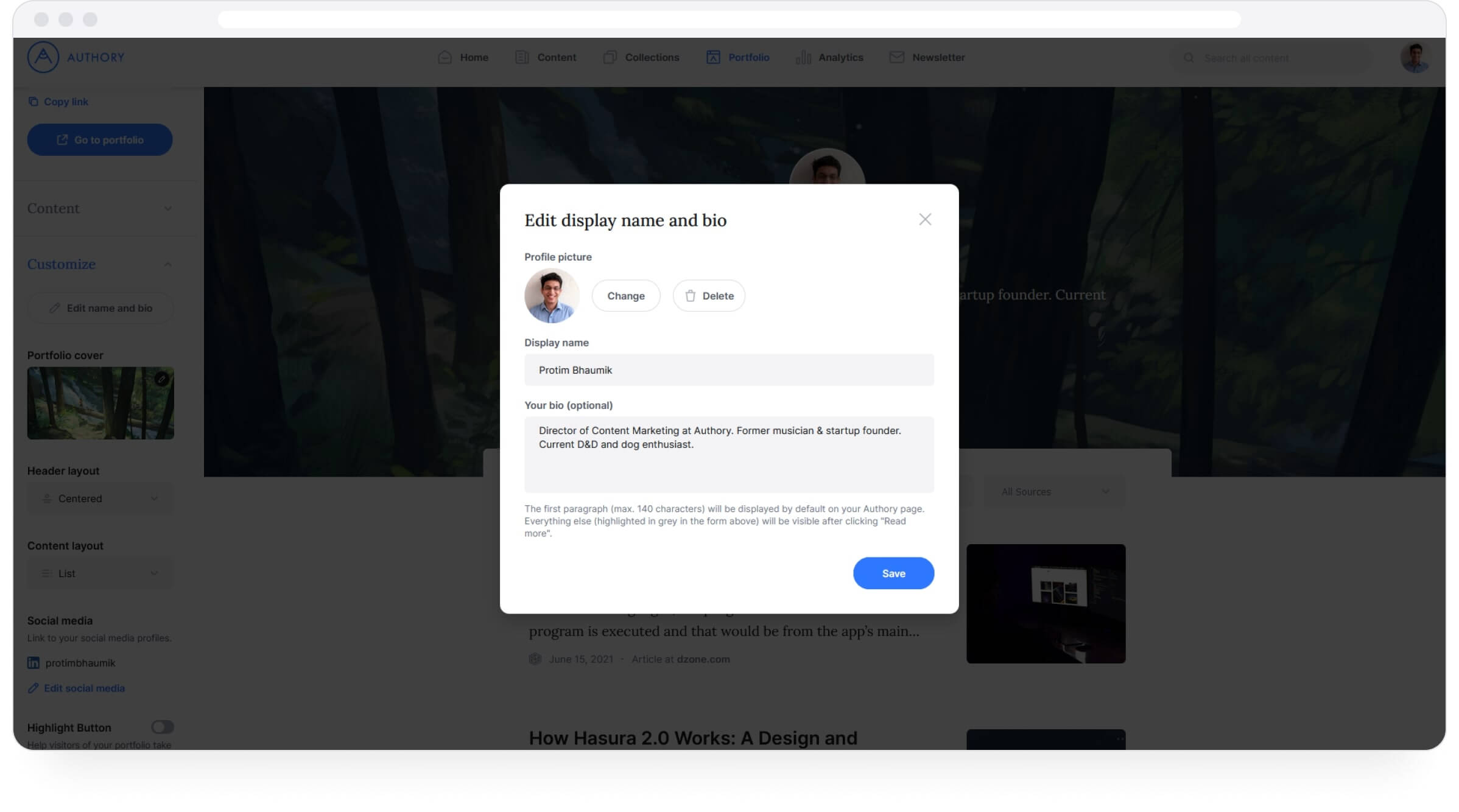
Step 5: Share with your prospective clients & publications
Now you can share your portfolio with prospects (which is at authory.com/YourName), or you can add your own domain name as well. Your portfolio is SEO-friendly and can easily be found using Google search.

You can also opt to share particular collections, as shown below. This extends to collections that are not publicly displayed — excellent for ghostwritten content and the like. Share these privately if you so choose, and they will not be indexed on Google search.

So, that's it! Five simple steps to set up your portfolio and be on your way!

Journalism Portfolio Examples
In the earlier section, we learned how to make a portfolio. For inspiration, here is a look at the journalism portfolios of some of the top journalists in the world.
Steven Levy
Steven Levy is a journalist and Editor at Large for WIRED. For around four decades, he's been writing on technology with columns in Rolling Stone and Macworld and leading technology coverage for Newsweek. The Washington Post has called him "America's premier technology journalist." His work has also appeared in Harper's Magazine, The New York Times Magazine, Esquire, The New Yorker, and Premiere.
Steven wanted a way to back up his work which spans many decades, and that's when he found Authory.
Steven’s portfolio can be found at: authory.com/StevenLevy
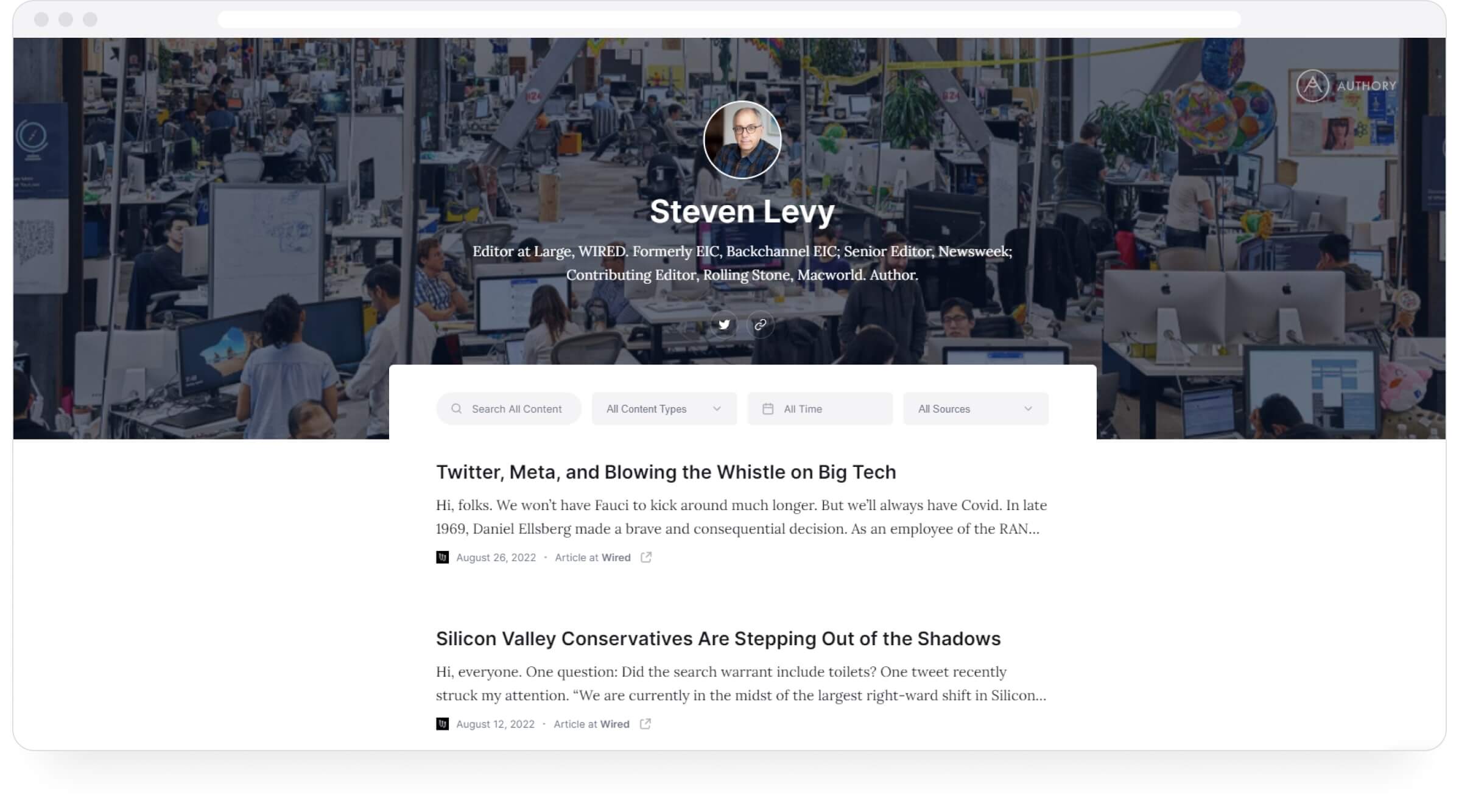
Annalisa Merelli
Annalisa Merelli is a senior reporter at Quartz and has over fifteen years of international experience in covering topics such as public health, healthcare, inequality, and social issues.
Since Quartz has changed ownership a few times, Annalisa wanted one place to store and present her content.
Annalisa’s portfolio can be found at: authory.com/AnnalisaMerelli
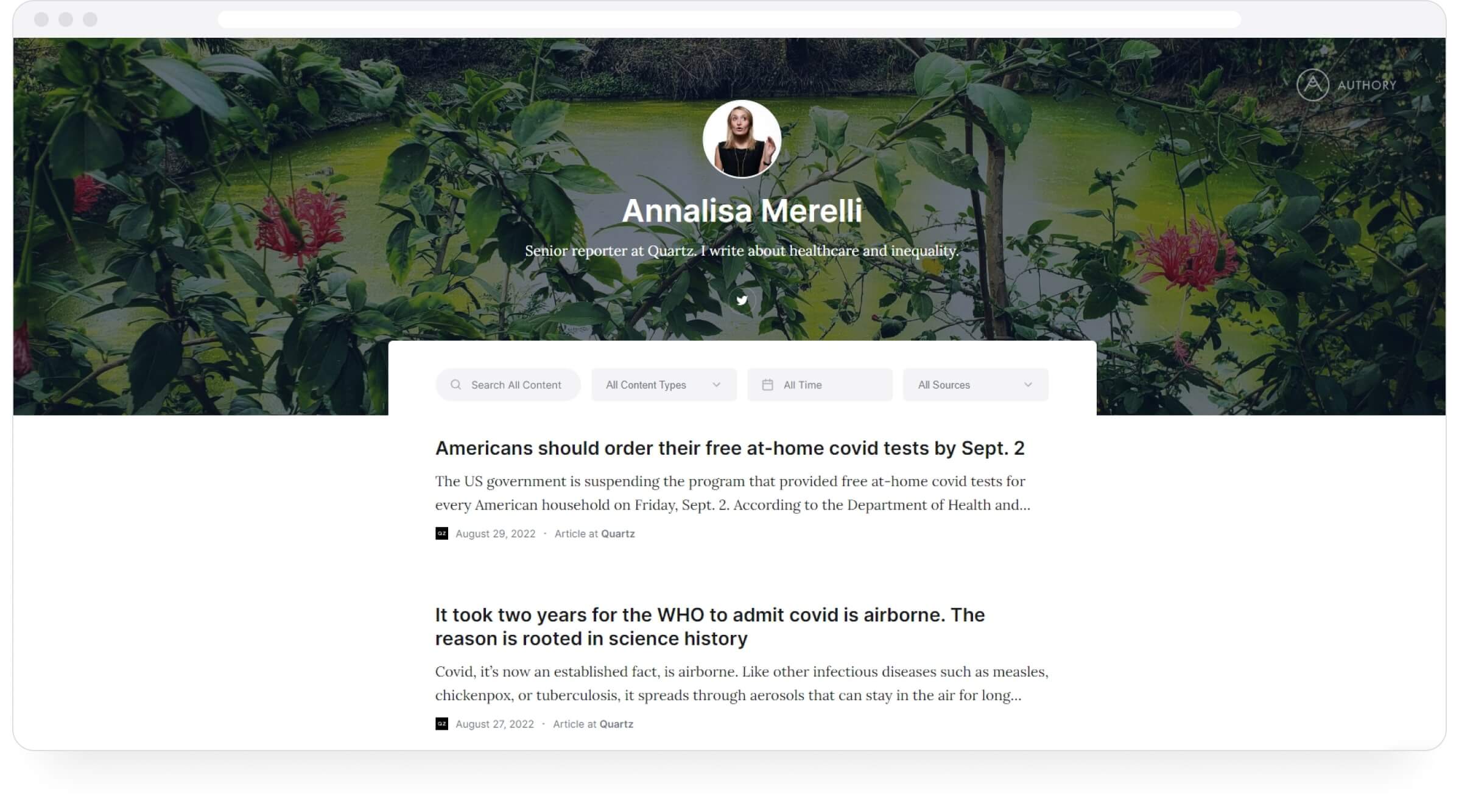
Tony Norman
Tony Norman, a columnist for the Pittsburgh Post-Gazette and President of the National Society of Newspaper Columnists, will be launching a podcast while also working as a freelancer for Vanity Fair. Tony is also an ICIJ (International Consortium of Investigative Journalists) board member and has been a journalist for over four decades.
Tony wanted to enhance his brand — super crucial for columnists — and he uses Authory to help him achieve this.
Tony’s portfolio can be found at: authory.com/TonyNorman

Theo Francis
Theo Francis is a Wall Street Journal business reporter covering topics such as executive pay, corporate disclosure, transparency, governance, and complexity. He has more than a decade of experience digging into complex financial, regulatory, economic, legal, and public-policy issues and explaining them to general audiences. He has also written for Quartz, The New York Times' DealBook, and footnoted.org.
Theo has split up his portfolio into topic-based collections.
Theo’s portfolio can be found at: authory.com/TheoFrancis
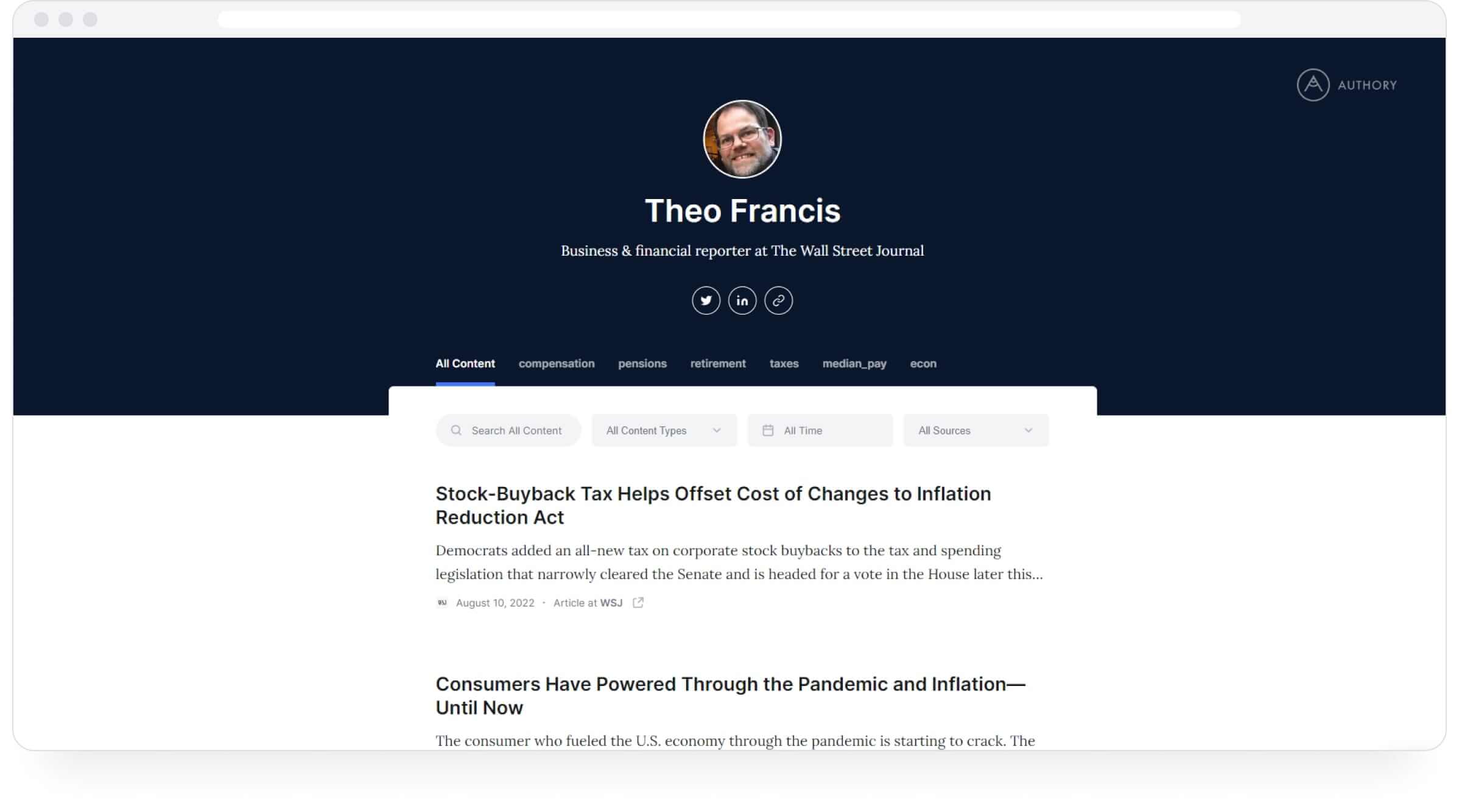
Glenn Fleishman
Glenn Fleishman is a Seattle-based technology journalist and author whose work has appeared in the Atlantic, American History, the Economist, Fast Company, Increment, the New York Times, and WIRED. He's currently a senior contributor at Macworld, where he has written for over 20 years and has contributed to TidBITS for over 30 years.
Glenn’s portfolio can be found at: authory.com/GlennFleishman

Glenn Fleishman's online portfolio on Authory
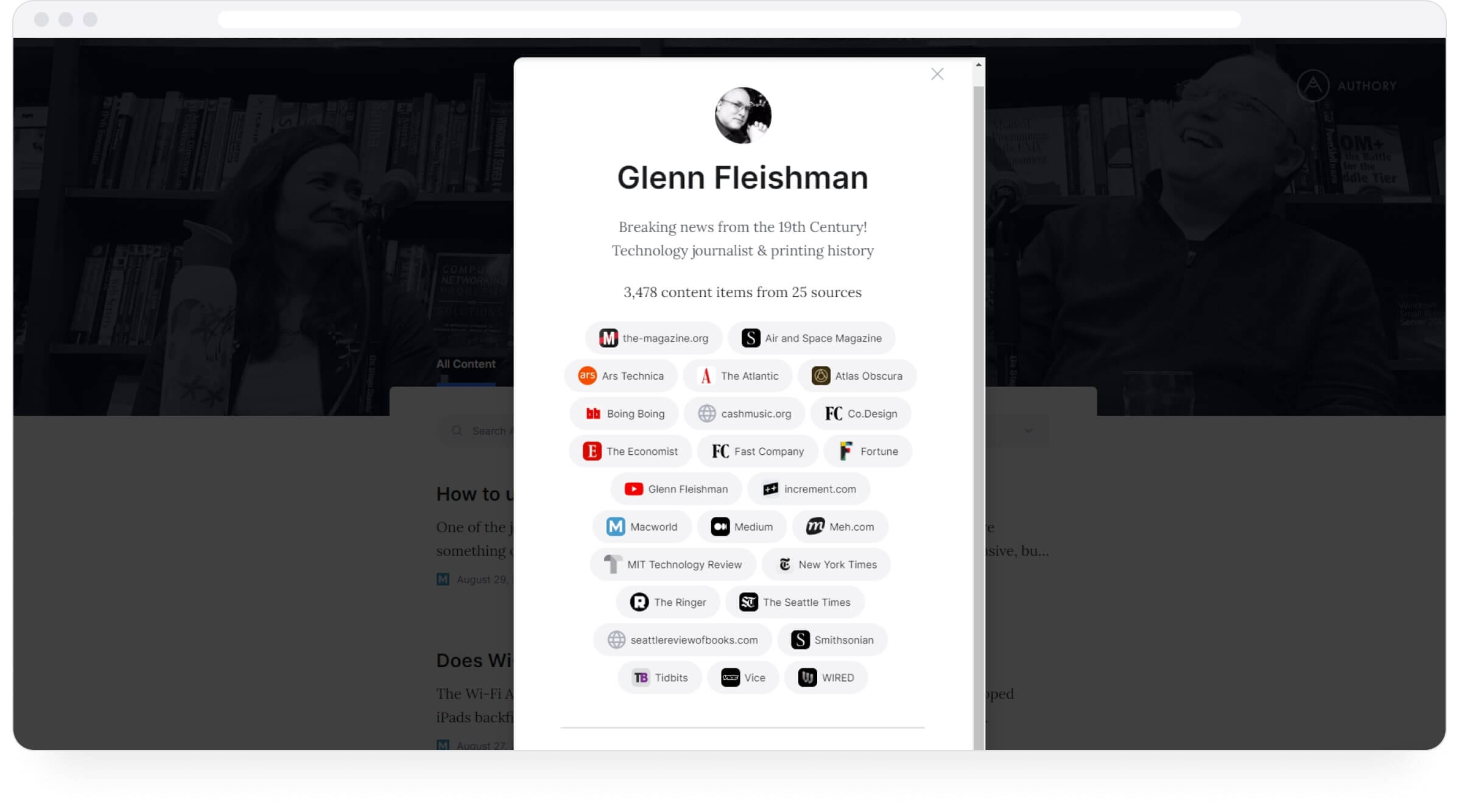

FAQs related to creating a journalism portfolio
What should be in a journalism portfolio?
A journalist portfolio website should contain all your content across various mediums and publications, presented via curated collections for easy parsing. It should also have your contact details, social media links, and a small write-up on who you are.
How do I create a journalism portfolio with no experience?
Start with all your college newspaper articles and build from there. Everyone needs to start somewhere. Collate all your writing that you've done for college or school and present that in your portfolio.
How do I create a journalism portfolio?
There are many professional portfolio builders available online. We recommend using Authory, where you can just add your sources, and Authory will auto-populate your entire portfolio. You can then divide all your content into relevant collections and share those specific collections with prospective clients and publications.
Do journalists need a website?
Journalists need an online journalism portfolio to portray who they are. In most cases, a journalism portfolio will cover their needs, especially something built on Authory, which auto-updates and works as a repository for all their content.
What's the difference between a journo portfolio and a freelance writing portfolio?
Online journalism & writing portfolios cater to different clientele. Journalists work on facts, report on actual events, and do so under tight deadlines. Writers sometimes work on fiction and have a wide range of industries that they may write for.
Each portfolio needs to speak to the audience that they're writing for. A journo portfolio, even a fashion journalism portfolio, must bring out the journalist's authenticity, while a writing portfolio may need to bring out the writer's creativity. In both cases, it's best practice to build a professional online portfolio.







